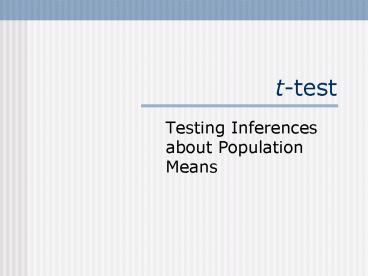t-test - PowerPoint PPT Presentation
1 / 27
Title:
t-test
Description:
Used when we have dependent samples matched, paired or tied somehow. Repeated measures. Brother & sister, husband & wife. Left hand, right hand, etc. ... – PowerPoint PPT presentation
Number of Views:1130
Avg rating:3.0/5.0
Title: t-test
1
t-test
- Testing Inferences about Population Means
2
Learning Objectives
- Compute by hand and interpret
- Single sample t
- Independent samples t
- Dependent samples t
- Use SPSS to compute the same tests and interpret
the output
3
Review 6 Steps for Significance Testing
- Set alpha (p level).
- State hypotheses, Null and Alternative.
- Calculate the test statistic (sample value).
- Find the critical value of the statistic.
- State the decision rule.
- State the conclusion.
4
One Sample Exercise (1)
Testing whether light bulbs have a life of 1000
hours
- Set alpha. ? .05
- State hypotheses.
- Null hypothesis is H0 ? 1000.
- Alternative hypothesis is H1 ? ? 1000.
- Calculate the test statistic
5
Calculating the Single Sample t
What is the mean of our sample?
800
750
940
970
790
980
820
760
1000
860
867
What is the standard deviation for our sample of
light bulbs?
SD 96.73
6
Determining Significance
- Determine the critical value. Look up in the
table (Heiman, p. 708). Looking for alpha .05,
two tails with df 10-1 9. Table says 2.262. - State decision rule. If absolute value of sample
is greater than critical value, reject null.
If -4.35 gt 2.262, reject H0.
7
Stating the Conclusion
- 6. State the conclusion. We reject the null
hypothesis that the bulbs were drawn from a
population in which the average life is 1000 hrs.
The difference between our sample mean (867) and
the mean of the population (1000) is SO different
that it is unlikely that our sample could have
been drawn from a population with an average life
of 1000 hours.
8
SPSS Results
Computers print p values rather than critical
values. If p (Sig.) is less than .05, its
significant.
9
t-tests with Two Samples
- Independent Samples t-test
- Dependent Samples t-test
10
Independent Samples t-test
- Used when we have two independent samples, e.g.,
treatment and control groups. - Formula is
- Terms in the numerator are the sample means.
- Term in the denominator is the standard error of
the difference between means.
11
Independent samples t-test
The formula for the standard error of the
difference in means
Suppose we study the effect of caffeine on a
motor test where the task is to keep a the mouse
centered on a moving dot. Everyone gets a drink
half get caffeine, half get placebo nobody knows
who got what.
12
Independent Sample Data (Data are time off task)
Experimental (Caff) Control (No Caffeine)
12 21
14 18
10 14
8 20
16 11
5 19
3 8
9 12
11 13
15
N19, M19.778, SD14.1164 N210, M215.1, SD24.2805
13
Independent Sample Steps(1)
- Set alpha. Alpha .05
- State Hypotheses.
- Null is H0 ?1 ?2.
- Alternative is H1 ?1 ? ?2.
14
Independent Sample Steps(2)
- 3. Calculate test statistic
15
Independent Sample Steps (3)
- Determine the critical value. Alpha is .05, 2
tails, and df N1N2-2 or 109-2 17. The
value is 2.11. - State decision rule. If -2.758 gt 2.11, then
reject the null. - Conclusion Reject the null. the population
means are different. Caffeine has an effect on
the motor pursuit task.
16
Using SPSS
- Open SPSS
- Open file SPSS Examples for Lab 5
- Go to
- Analyze then Compare Means
- Choose Independent samples t-test
- Put IV in grouping variable and DV in test
variable box. - Define grouping variable numbers.
- E.g., we labeled the experimental group as 1 in
our data set and the control group as 2
17
Independent Samples Exercise
Experimental Control
12 20
14 18
10 14
8 20
16
Work this problem by hand and with SPSS. You
will have to enter the data into SPSS.
18
SPSS Results
19
Dependent Samples t-tests
20
Dependent Samples t-test
- Used when we have dependent samples matched,
paired or tied somehow - Repeated measures
- Brother sister, husband wife
- Left hand, right hand, etc.
- Useful to control individual differences. Can
result in more powerful test than independent
samples t-test.
21
Dependent Samples t
Formulas
t is the difference in means over a standard
error.
The standard error is found by finding the
difference between each pair of observations.
The standard deviation of these difference is
SDD. Divide SDD by sqrt(number of pairs) to get
SEdiff.
22
Another way to write the formula
23
Dependent Samples t example
Person Painfree (time in sec) Placebo Difference
1 60 55 5
2 35 20 15
3 70 60 10
4 50 45 5
5 60 60 0
M 55 48 7
SD 13.23 16.81 5.70
24
Dependent Samples t Example (2)
- Set alpha .05
- Null hypothesis H0 ?1 ?2. Alternative is H1
?1 ? ?2. - Calculate the test statistic
25
Dependent Samples t Example (3)
- Determine the critical value of t.
- Alpha .05, tails2
- df N(pairs)-1 5-14.
- Critical value is 2.776
- Decision rule is absolute value of sample value
larger than critical value? - Conclusion. Not (quite) significant. Painfree
does not have an effect.
26
Using SPSS for dependent t-test
- Open SPSS
- Open file SPSS Examples (same as before)
- Go to
- Analyze then Compare Means
- Choose Paired samples t-test
- Choose the two IV conditions you are comparing.
Put in paired variables box.
27
Dependent t- SPSS output































